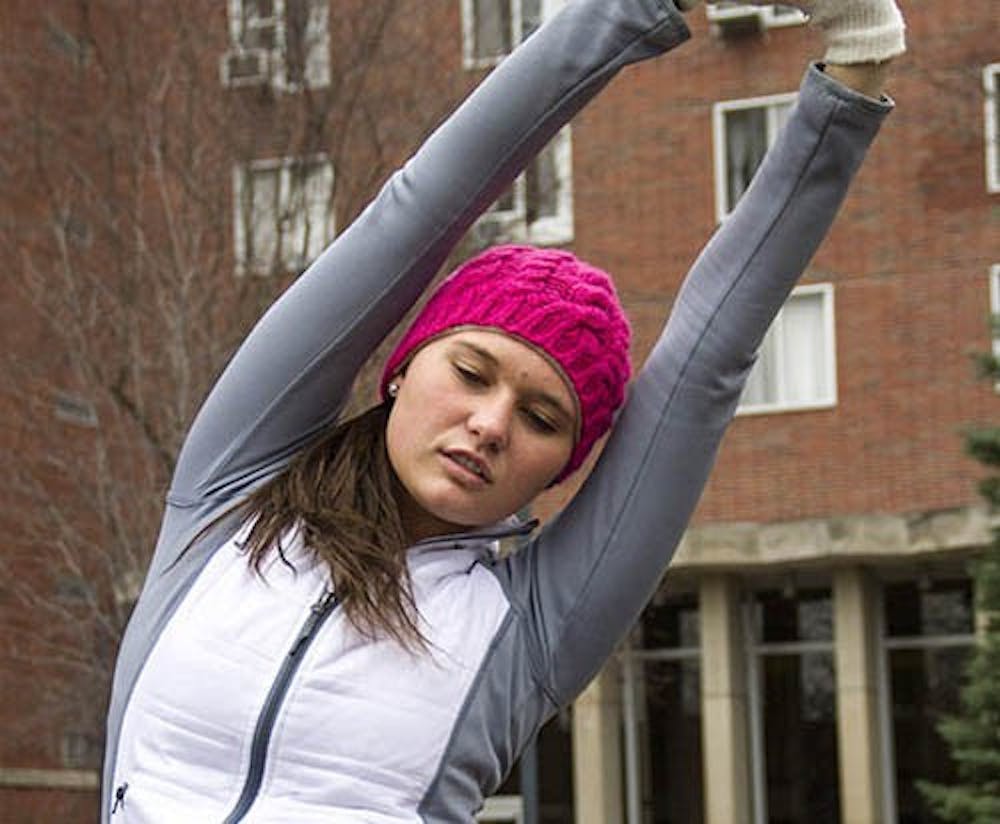Alex Donaldson has been running consistently since the fourth grade, now dedicating time for it five to six days out of the week. While the dropping temperatures of winter months don’t change the number of times she works out, they may change other things about it. The junior pubilc relations major prefers running outside due to the scenery, but as the temperature decreases she transitions her exercises indoors.
Whether making a transition to inside or accomodating to outside, many fitness routines may need to be altered to complement the colder weather.
MOVING INSIDE
When it comes to sprint training, or any other fast paced workout, Ali Bishel, assistant cross country and track coach, recommends moving inside.
The temperature of the oxygen outside will take longer for the body to heat up than oxygen inside, she said. This will only make the workout more difficult than it needs to be.
“Sometimes, I feel like my lungs are on fire,” Donaldson said. “[Running inside] can be more intense cause I know exactly how much I’m running.”
Taking advantage of workout videos and websites can add variety to an otherwise dull routine.
She finds the cold air to be not as motivating and extremely uncomfortable to breathe in while running.
Freshmen finance major Niles Mosher, who has in the past trained with the Marines, prefers to gather workout routines from the web site bodybuilding.com. The site contains a slew of information regarding different workout routines and information. When done correctly, basic core building routines such as push ups, pull ups and crunches can be just as efficient as using weights.
“The internet is your friend,” he said. “There is all sorts of information from different forums and websites. It’s convenient, and you don’t have to factor in things like going to the gym.”
Articles on the site feature various at-home workout routine combinations and winter workouts. For example, one article states that working outside in colder temperatures actually burns more calories; the core temperature of a human body drops when in colder weather. By bringing the temperature back up, the body exerts energy, which in turn burns calories.
BRAVING THE COLD
While moving inside is an option, sophomore business major Christian Gonzalez prefers the colder weather.
“My muscles just get so baked in the sun,” said Gonzalez, the president of Ball State’s soccer club.
Bishel said running outdoors can be suitable for those running at a marathon type pace or perhaps for a warm up activity.
But the correct precautions must be taken when dressing for cold weather as well to avoid complications.
“It’s always better to be overdressed than underdressed,” Bishel said. “Everyone’s different, but always dress warmer than you think you need.”
Clothing such as liner gloves, complemented by heavier duty gloves on top, work well for keeping the hands heated.
The head is the most important part of the body to keep covered when outdoors, Bishel said. She recommends a headband, or hat, anything that keeps the ears and the majority of the head covered.
When working out in the cold, Gonzalez prefers ClimaCool shirts and pants by Adidas. The material is thinner than average sweatpants or sweatshirts and is extremely flexible, yet maintains body heat.


